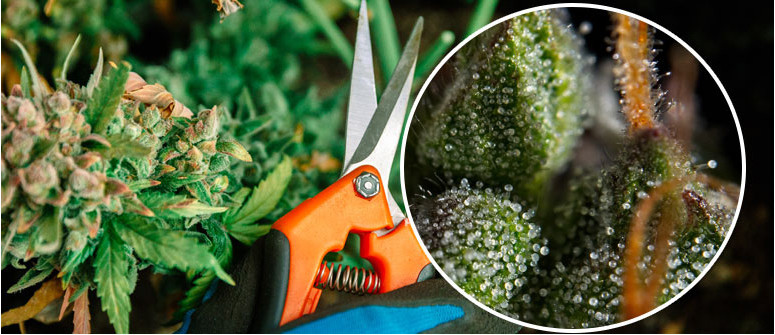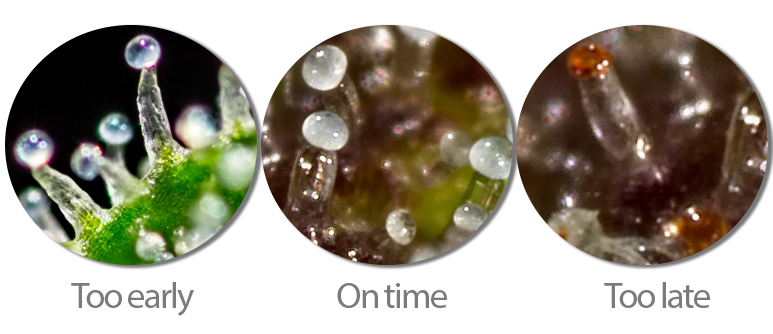Cut down your plants at the right time to get the best weed

Want to find out when to cut down your plants at the right time? How can you tell if a crop is ready? What time of day to harvest? We've got you covered.
After investing months into properly cultivating your prized cannabis plants, you don’t want to spoil your finished crop by harvesting too early or waiting too long. Experienced growers know there’s a sweet spot at the end of the flowering cycle when the buds are at peak concentration to produce maximum effects.
Harvesting too early results in both cannabinoids, that have not fully optimized and sparse, diminished yields, while harvesting late causes the THC to degrade after hitting its peak. Never fear, knowing when to cut down your plants at the right time is not a difficult skill to learn. As long as you have a magnifying glass and a passion for your plants, you’ll see a difference in this year’s yield.
TWO METHODS: PISTILS & TRICHOMES

So, how exactly do confident cultivators know when to reach for the axe? As it happens, there are two popular methods for recognizing if flowers are ready to harvest and they both adhere to similar rules.
PISTILS
Pistils are long hairs on the flowers of cannabis, that collect pollen from male plants during fertilization. Additionally, they are the most superficial method for telling if a crop is ready to harvest. Throughout much of the growing process, pistils retain a dove-white color until buds start getting closer to maximizing cannabinoid efficacy. The older the plant gets, the pistils begin to take on an amber hue and curl inward, before ultimately becoming a dark brown color, in which case the yield is past its due.
A good rule of thumb when following the pistil recognition method is to wait until around half of the pistils have turned amber and curl - wait any longer and the crop will sustain more indica-dominant effects when smoking, such as couchlock and fatigue.
TRICHOMES
The more exact method for assessing your plants’ readiness is to examine the trichomes under a magnifying glass. Like the pistil rule, cultivators are looking for a change in color to determine the time to strike. Trichomes are the all-important resin glands on flowers, that secrete notable compounds like THC and terpenes.
These mushroom shaped hairs are transparent until the flowering phase when they begin to turn cloudy white. This is the 24-karat phase of cannabinoid concentration, that alerts experienced growers, that the time to act is now. Past this point, trichomes turn an amber color, signaling, that the THC content has likely begun to degrade.
As with any other horticultural expedition, the above “rules” vary depending on the strain and other conditions. Different breeding methods result in more exceptions to the growing “standards”, that are in place today. The best way to clear up any doubts you have with growing a new strain is to ask your peers about their personal experiences with it. Advice from other growers can really derail an operation, but it can also help a great deal. Consider conducting some online research to see if your strain has any noted inconsistencies in harvest time.
TIME TO HARVEST
Now that you’ve gauged your crop’s readiness to harvest, you’ll heave to wait for early morning or nightfall, until you can harvest in mostly darkness. While a seemingly subtle difference, the time of day you harvest can greatly impact the taste and harshness of your cured final buds. Harvesting in light exposure is said to leach nutrients and possibly interfere with THC concentration. Other theories posit, that the food produced by photosynthesis moves down to the root system at night, away from the buds.
SHARP SHEARS!
In terms of actually harvesting each plant, make sure to have a sharp set of garden shears and gardening gloves at hand. To start, be sure, that most of the larger fan leaves have been removed - this will make your life easier trying to navigate with your shears. Next, cut the entire plant away from the root system.
And there you have it! A beautiful harvested plant that has reached its full potential and is ready to move to the final phases of the cultivation process: drying and curing. After that, the flowers can be finally smoked, extracted and enjoyed by all!




